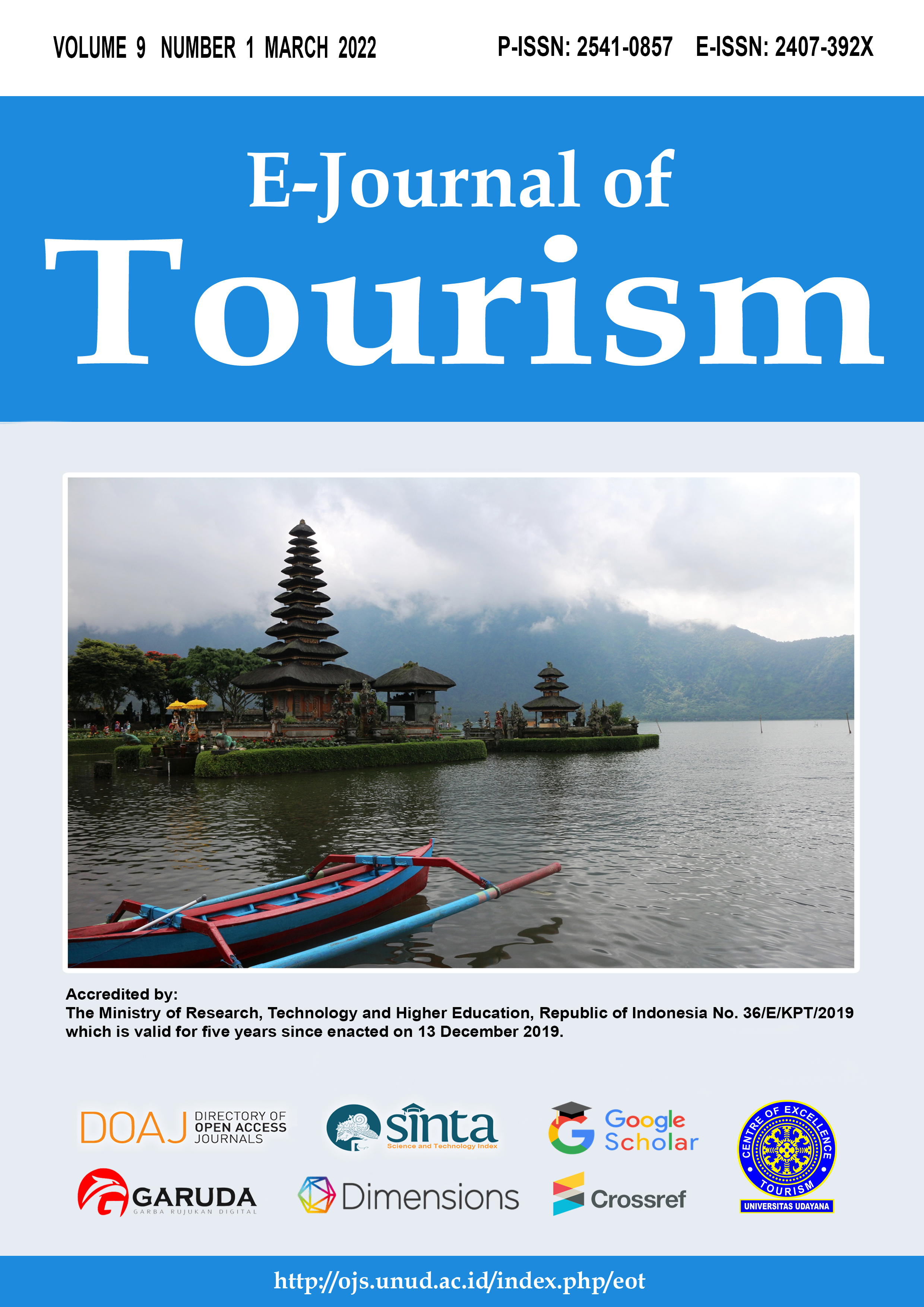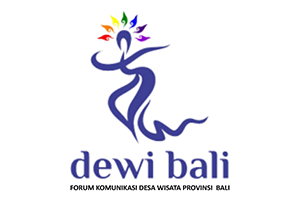Tourism Potential Evaluation and Strategy Formulation for Pine Forest of Gelagahlinggah; Experience From A Community Engagement
Abstract
This article is written based on a research conducted as part of a series of community engagement done by Lecturers of Tourism Destination Program of Bali Tourism Polytechnic for the community of Gelagahlinggah Customary Village. The village is located at Kintamani of Bangli Regency, and is part of buffer zone for Batur UNESCO Global Geopark. The aim of the research was to evaluate the tourism potential of the pines forest of Gelagahlinggah, and to produce strategies to develop those potentials. The research implemented quantitative and qualitative approach, utilizing survey as the method for collecting primary data. To increase the validity of the data, the sample was determined purposively. Therefore, the respondents should understand the existing condition of the pines forest of Gelagahlinggah Village, and able to evaluate its tourism potentials. The questionnaire was developed on Google form to allows for practicality. A sample of 100 respondents were collected, based on which a dataset was then prepared for analysis. The analysis using Exploratory Factor Analysis (EFA) to extract factors in the form of strengths, weaknesses, opportunities and threats indicating the tourism potentials of the pine forest of Gelagahlinggah. The tourism potentials were then processed in a SWOT Matrix to develop strategies for those tourism potentials. The research result reveals some tourism potentials of the pine forest of Gelagahlinggah, and strategies suitable to develop those potentials.
Keywords: tourism potentials, evaluation, pine forest, strategy
Downloads
References
Budiasa, I. M., Suparta, I. K., & Nurjaya, I. W. (2019). Implementation of Green Tourism Concept on Glamping Tourism in Bali. 2nd International Conference on Applied Science and Technology 2019 - Social Sciences Track. Atrantis Press.
Burkart, A. d. (1976). Tourism Past Present and Future. London: Heinemann.
Calzada, I. (2020). Democratising Smart Cities? Penta-Helix Multistakeholder Social Innovation Framework. Smart Cities. doi:10.3390/smartcities3040057
Calzada, I., & Cowie, P. (2017). Beyond Smart & Data-Driven City-Regions? Rethinking Stakeholder-Helixes Strategies. Regions Magazine. doi:10.1080/13673882.2017.11958675
Cooper, C. (2016). Essentials Of Tourism Second Edition. Harlow: Pearson Education Limited.
David, F. R. (2011). Strategic Management Concepts and Cases. New Jersey: Prentice Hall.
Dillette, A. K., Douglas, A. C., & Andrzejewski, C. (2018). Yoga tourism – a catalyst for transformation. Annals of Leisure Research. doi:10.1080/11745398.2018.1459195
Duglio, S., Bonadonna, A., Letey, M., Peira, G., Zavattaro, L., & Lombardi, G. (2019). Tourism Development in Inner Mountain Areas—The Local Stakeholders’ Point of View through a Mixed Method Approach. Sustainability. doi:10.3390/su11215997
Etzkowitz, H., & Leydesdorff, L. (2000). The dynamics of innovation: from National Systems and ‘‘Mode 2’’ to a Triple Helix of university–industry–government relations. Research Policy, 109–123.
Farkic, J., Isailovic, G., & Taylor, S. (2021). Forest bathing as a mindful tourism practice. Annals of Tourism Research Empirical Research. doi:https://doi.org/10.1016/j.annale.2021.100028
Field, A. (2017). Discovering Statistics Using IBM SPSS Statistics, 5th Edition. SAGE Publications.
Fletcher, J., Fyall, A., Gilbert, D., & Wanhil, S. (2018). Tourism Principles And Practice. Harlow: Pearson Education Limited.
Goddard, J., & Kempton, L. (2016). The Civic University Universities in leadership and management of place. CURDS Newcastle University.
Hair, J. H., Black, W. C., Babin, B. J., & Anderson, R. E. (2014). Multivariate Data Analysis Seventh Edition. Essex: Pearson Education Limited.
Hardya, A., & Pearson, L. J. (2017). Examining stakeholder group specificity: An innovative sustainable tourism approach. Journal of Destination Marketing & Management. doi:http://dx.doi.org/10.1016/j.jdmm.2017.05.001
Hoang, H. T., Truong, Q. H., Nguyen, A. T., & Hens, L. (2018). Multicriteria Evaluation of Tourism Potential in the Central Highlands of Vietnam: Combining Geographic Information System (GIS), Analytic Hierarchy Process (AHP) and Principal Component Analysis (PCA). Sustainability. doi:10.3390/su10093097
Islam, M. W., Ruhanen, L., & Ritchie, B. W. (2017). Adaptive co-management: A novel approach to tourism destination governance? Journal of Hospitality and Tourism Management. doi:10.1016/j.jhtm.2017.10.009
Joung, D., Lee, B., Lee, J., Lee, C., Koo, S., Park, C., . . . Park, B.-J. (2020). Measures to Promote Rural Healthcare Tourism with a Scientific Evidence-Based Approach. International Journal of Environmental Research and Public Health. doi:10.3390/ijerph17093266
Leister, W. (2019). Strengthening Tourists’ Engagement in Guided Hiking and Trekking. Administrative Science. doi:10.3390/admsci9020045
Lester, P., Inman, D., & Bishop, L. (2014). Handbook Of Tests and Measurement in Education and The Social Sciences, Third Edition. Lanham: Rowman & Littlefield.
Likert, R. (1932). A Technique For The Measurement Of Attitudes. (R. Woodworth, Ed.) Archives Of Psychology, 140, 5 - 55.
Mamun, A. A., & Mitra, S. (2012). A Methodology for Assessing Tourism Potential: Case Study Murshidabad District, West Bengal, India. International Journal of Scientific and Research Publications, 2. Retrieved from www.ijsrp.org
Manaf, A., Purbasari, N., Damayanti, M., Aprilia, N., & Astuti, W. (2018). Community-Based Rural Tourism in Inter-Organizational Collaboration: How Does It Work Sustainably? Lessons Learned from Nglanggeran Tourism Village, Gunungkidul Regency, Yogyakarta, Indonesia. Sustainability. doi:10.3390/su10072142
Mathias, S., Daigle, P., Dancause, K. N., & Gadais, T. (2020). Forest bathing: a narrative review of the effects on health for outdoor and environmental education use in Canada. Journal of Outdoor and Environmental Education. doi:10.1007/s42322-020-00058-3
Ohe, Y., Ikei, H., Song, C., & Miyazaki, Y. (2017). Evaluating the relaxation effects of emerging forest-therapy tourism: A multidisciplinary approach. Tourism Management. doi:http://dx.doi.org/10.1016/j.tourman.2017.04.010
Poudel, S., & Nyaupane, G. P. (2016). Exploring the Roles of Tour Guides in Trekking Tourism. University of Massachusetts Amherst. Retrieved from https://scholarworks.umass.edu/ttra/2011/Visual/47
Pretty, J. (2004). How Nature Contributes to Mental and Physical Health. Spirituality and Health International, 68-78.
Puška, A., Pamucar, D., Stojanovic, I., Cavallaro, F., Kaklauskas, A., & Mardani, A. (2021). Examination of the Sustainable Rural Tourism Potential of the Brˇcko District of Bosnia and Herzegovina Using a Fuzzy Approach Based on Group Decision Making. Sustainability. doi:10.3390/su13020583
Puška, A., Stojanović, I., & Maksimović, A. (2019). Evaluation of sustainable rural tourism potential in Brcko district of Bosnia and Herzegovina using multi-criteria analysis. Operational Research in Engineering Sciences: Theory and Applications. doi:10.31181/oresta190261p
Rinaldi, C., Cavicchi, A., & Robinson, R. N. (2020). University contributions to co-creating sustainable tourism destinations. Journal of Sustainable Tourism. doi:10.1080/09669582.2020.1797056
Rozycki, P., & Dryglas, D. (2014). Trekking as a phenomenon of tourism in the modern world. Acta Touristica, 24 - 40.
Saito, H., & Ruhanen, L. (2017). Power in tourism stakeholder collaborations: Power types and power holders. Journal of Hospitality and Tourism Management. doi:http://dx.doi.org/10.1016/j.jhtm.2017.01.001
Sestras, P., Rosca, S., Bilasco, S., Nas, S., Buru, S. M., Kovacs, L., . . . Sestras, A. F. (2020). Feasibility Assessments Using Unmanned Aerial Vehicle Technology in Heritage Buildings: Rehabilitation-Restoration, Spatial Analysis and Tourism Potential Analysis. Sensors. doi:10.3390/s20072054
Sharma, N. P. (2020). Meditation Tourism, Buddhist Philosophy in Practice: A Case Study of Lumbini, Nepal. The Gaze Journal of Tourism and Hospitality.
Yan, L., Gao, B. W., & Zhang, M. (2017). A mathematical model for tourism potential assessment. Tourism Management. doi:http://dx.doi.org/10.1016/j.tourman.2017.07.003

This work is licensed under a Creative Commons Attribution 4.0 International License.
The copyright of the received article shall be assigned to the journal as the publisher of the journal. The intended copyright includes the right to publish the article in various forms (including reprints). The journal maintains the publishing rights to the published articles.




















